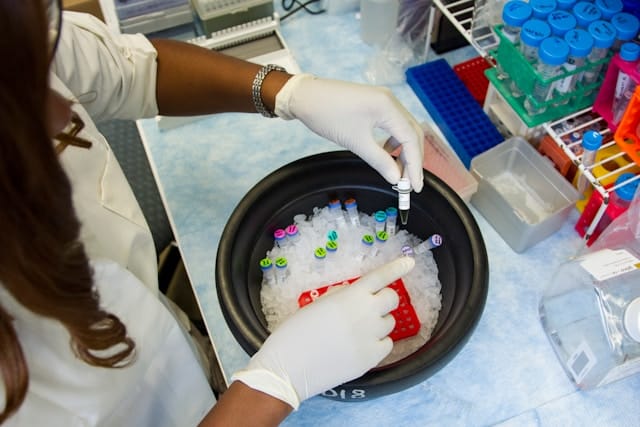Hematopoietic stem cells (HSCs) are the cornerstone of the human body’s ability to produce and replenish blood cells. These remarkable cells reside primarily in the bone marrow and have the unique ability to self-renew, differentiate, and give rise to all the different types of blood cells, including red blood cells, white blood cells, and platelets. Without these cells, the body would struggle to maintain its blood supply, leading to severe consequences for overall health.
In recent years, hematopoietic stem cells have gained significant attention due to their critical role in medical treatments, particularly for patients suffering from blood-related diseases such as leukemia, lymphoma, and anemia. Advances in hematopoietic stem cell transplants and research into the properties of these cells have made it possible to treat previously incurable conditions. This blog post will explore the biology, function, and medical applications of hematopoietic stem cells, their importance in maintaining the body’s blood supply, and how they are used in life-saving therapies.
The Biology of Hematopoietic Stem Cells
Hematopoietic stem cells are a type of multipotent stem cell, meaning they have the ability to differentiate into multiple types of cells within the hematopoietic (blood-forming) system. These stem cells are primarily found in the bone marrow but can also be present in smaller quantities in peripheral blood and umbilical cord blood. The remarkable ability of HSCs to self-renew and differentiate into various blood cell lineages is essential for maintaining the body’s homeostasis.
Hematopoiesis: The Process of Blood Formation
The process through which hematopoietic stem cells generate new blood cells is known as hematopoiesis. This complex process occurs primarily in the bone marrow but can also happen in other tissues, especially during fetal development and in certain pathological conditions. Hematopoiesis ensures that the body has a constant supply of blood cells to transport oxygen, fight infections, and promote clotting.
During hematopoiesis, hematopoietic stem cells differentiate into two major progenitor cell types: myeloid progenitor cells and lymphoid progenitor cells. These progenitor cells then give rise to various blood cells, including:
- Myeloid lineage: Red blood cells, platelets, neutrophils, eosinophils, basophils, monocytes, and macrophages.
- Lymphoid lineage: B cells, T cells, and natural killer (NK) cells.
Each of these cell types plays a crucial role in the body’s immune system, oxygen transport, and tissue repair.
The Function of Hematopoietic Stem Cells
The primary function of hematopoietic stem cells is to ensure a continuous and balanced supply of blood cells throughout a person’s life. They achieve this by undergoing asymmetric cell division, where one daughter cell retains the properties of the original HSC, while the other differentiates into a specific type of blood cell. This process of differentiation is tightly regulated to meet the body’s needs for oxygen, immunity, and clotting.
HSCs are also capable of migrating to various parts of the body when needed. For example, during infection or injury, signals can prompt hematopoietic stem cells to move from the bone marrow into the bloodstream or damaged tissues, where they aid in repairing and replenishing blood cells.
Medical Applications of Hematopoietic Stem Cells
The most well-known and widely used application of hematopoietic stem cells is in stem cell transplantation. Hematopoietic stem cell transplants (HSCTs) are used to treat a variety of blood-related disorders, such as leukemia, lymphoma, and aplastic anemia, by replacing damaged or diseased bone marrow with healthy hematopoietic stem cells. This process can be life-saving for patients who have exhausted other treatment options.
Types of Hematopoietic Stem Cell Transplantation
There are two primary types of hematopoietic stem cell transplantation: autologous and allogeneic.
Autologous Hematopoietic Stem Cell Transplantation: In this procedure, the patient’s own stem cells are harvested, typically before they undergo high doses of chemotherapy or radiation. The stem cells are then reintroduced into the patient’s body to restore blood cell production. Autologous transplants are commonly used for patients with certain types of cancers, such as multiple myeloma or lymphoma, where the risk of relapse is lower.
Allogeneic Hematopoietic Stem Cell Transplantation: In an allogeneic transplant, stem cells are donated by another person, often a close relative or matched donor. This type of transplant is typically used when a patient’s own stem cells are damaged or destroyed, such as in cases of leukemia. While this approach can lead to better outcomes for some patients, it also carries risks, such as graft-versus-host disease (GVHD), where the donor’s immune cells attack the patient’s body.
Advances in Stem Cell Transplantation
Recent advances in technology and research have improved the outcomes of hematopoietic stem cell transplants. For instance, the use of reduced-intensity conditioning (RIC) regimens, also known as “mini transplants,” has allowed older or more fragile patients to undergo HSCTs. RIC uses lower doses of chemotherapy and radiation, reducing the risks of complications while still providing the patient with a potentially curative treatment.
Umbilical cord blood transplants have also emerged as a promising source of hematopoietic stem cells, especially for patients who do not have a fully matched donor. Cord blood stem cells are more primitive and less likely to cause graft-versus-host disease, making them an attractive option for certain patients.
Challenges in Hematopoietic Stem Cell Transplantation
Despite the potential benefits of hematopoietic stem cell transplantation, there are several challenges that patients and clinicians face. One major issue is the availability of suitable donors. While public and private bone marrow registries have expanded, many patients, especially those from minority ethnic backgrounds, struggle to find a perfect match.
Another challenge is the risk of complications such as graft-versus-host disease (GVHD) in allogeneic transplants. GVHD occurs when the donor’s immune cells recognize the patient’s tissues as foreign and begin attacking them, leading to a range of symptoms that can be mild or, in severe cases, life-threatening.
Hematopoietic Stem Cells in Research and Future Therapies
The unique properties of hematopoietic stem cells have made them a subject of intense research in the field of regenerative medicine. Scientists are exploring ways to harness the power of HSCs for treating not only blood disorders but also a wide range of other diseases, including autoimmune conditions, genetic disorders, and even neurological diseases.
Gene Therapy and Hematopoietic Stem Cells
One of the most promising areas of research involves the use of gene therapy in combination with hematopoietic stem cells. In this approach, scientists can modify the genetic material of HSCs to correct mutations that cause genetic diseases. These modified stem cells are then reintroduced into the patient’s body, where they begin producing healthy blood cells with the corrected gene.
Gene therapy using hematopoietic stem cells has shown great potential in treating genetic disorders such as sickle cell anemia and severe combined immunodeficiency (SCID). Early clinical trials have demonstrated that patients treated with gene-modified HSCs can achieve long-lasting remission and, in some cases, a complete cure.
Immunotherapy and Hematopoietic Stem Cells
Immunotherapy is another area where hematopoietic stem cells are playing a key role. Researchers are developing therapies that involve engineering HSCs to produce immune cells that are better equipped to fight cancer. For example, chimeric antigen receptor (CAR) T-cell therapy, a groundbreaking cancer treatment, involves modifying a patient’s T cells to recognize and attack cancer cells. By combining CAR-T therapy with hematopoietic stem cell transplantation, scientists hope to create more effective and long-lasting cancer treatments.
Hematopoietic Stem Cells and Aging
As the body ages, the function and regenerative capacity of hematopoietic stem cells decline. This leads to a reduction in the production of new blood cells, contributing to age-related conditions such as anemia and weakened immune responses. Understanding how aging affects HSCs is critical for developing interventions that can enhance healthy aging and improve the quality of life for older adults.
Recent studies have shown that certain environmental factors, such as chronic inflammation and oxidative stress, can accelerate the aging of HSCs. Researchers are exploring ways to protect HSCs from these stressors, with the goal of developing therapies that can preserve the function of these cells as we age.
The Ethical Considerations of Hematopoietic Stem Cell Research
As with any cutting-edge medical research, the use of hematopoietic stem cells raises important ethical considerations. One major area of debate centers around the use of embryonic stem cells, which are derived from early-stage embryos. While hematopoietic stem cells used in transplants and research are typically harvested from bone marrow or cord blood, the ethical issues surrounding stem cell research more broadly have implications for the field.
Another ethical concern involves access to treatment. Hematopoietic stem cell transplants are often expensive and require highly specialized medical care, making them inaccessible to many patients, particularly in low-income countries. Ensuring equitable access to these life-saving therapies is a key challenge for policymakers and healthcare providers.
Conclusion: The Future of Hematopoietic Stem Cells
The field of hematopoietic stem cells is evolving rapidly, with exciting new therapies and research emerging every year. These stem cells have already revolutionized the treatment of many blood-related diseases, and their potential applications in gene therapy, immunotherapy, and regenerative medicine hold promise for the future.
As researchers continue to unlock the secrets of hematopoietic stem cells, we can expect even more groundbreaking discoveries that will expand the possibilities for treating a wide range of diseases. However, challenges such as donor availability, treatment accessibility, and ethical considerations must be addressed to ensure that these life-saving therapies can benefit all patients in need.






